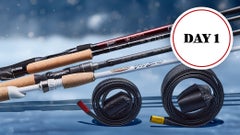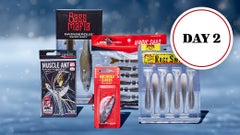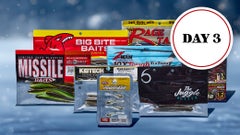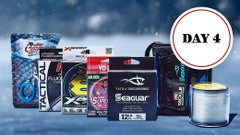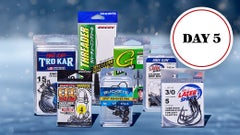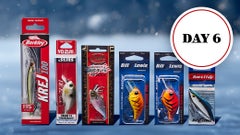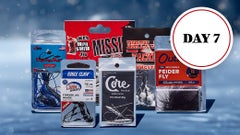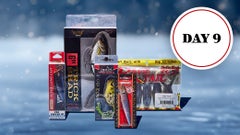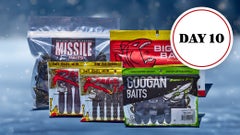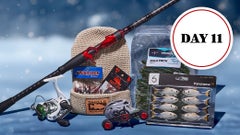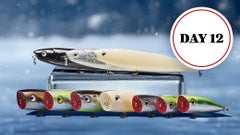Jason Chrisite Wins BASS Lake Dardanelle
Jason Christie's Winning Pattern, Baits & Gear
Christie didn't arrive at Dardanelle until last Monday morning after placing 5th at the Toyota Texas Bass Classic at Lake Fork the previous day. He launched at Spadra Creek around 11 a.m. and spent his day in there. "I thought that's where I'd end up fishing," he said. After seeing a lot of rain in the forecast for the coming days, he opted to scratch all of the creeks off his list, knowing some of them would be borderline unfishable with the rising, dirty water. "I felt like with the water getting dirtier, water willow would be a big key and I didn't see a lot of it in Spadra," he said. "There were more cattails, wood and lily pads in there." On Tuesday, he fished the lower end of the lake and on Wednesday, he launched on the lower end with the intent of fishing up to Spadra Creek, but never got anything going that way. "Once it started raining, I started looking for areas with potential rather than fished," he said. "I fished some, but I really just looked for spots I liked the looks of. "In Illinois Bayou, there wasn't a better part of it. It was all about fishing the wind and current in the water willow. When you could both together, that's when it was good." He deemed his practice average, but he figured if he could focus on one area and narrow down his techniques he'd have a shot at catching quality post-spawn fish that were sliding up and down with the current changes. He also felt comfortable committing to a shallow-water pattern with the amount of rain that came in, which put a good deal of stain in the water. Still, he had no inkling that he was around the winning fish. "The thing that bothered me in practice was I didn't have an area where I thought I could go and just catch 'em," he said. "I had the choice of fishing Illinois Bayou or Spadra. The thing about Spadra was I caught some good weights there, but I caught them cranking and flipping and it was just here and there. There wasn't a set way to catch them. "In Illinois Bayou, it was surrounded by water willow and I'm pretty familiar with it and I've fished it a bunch. I had a lot of experience with fish and how they act in it when the water comes up and the current gets going."
Competition:
At takeoff on day 1, Christie faced a coin-flip choice of whether to fish at Spadra or stay in Illinois Bayou. He ultimately chose the latter and wound up spending his whole tournament in there. The weights across the board were surprisingly strong on day 1 and his 16-07 stringer put him in 26th place. He said he fished the entire area and there was a considerable amount of fishing pressure within the bayou, but he stuck it out. "I was just fishing to move up in points and get a good finish," he said. A 2-hour fog delay at the start of day 2 caused him some consternation as the time immediately after takeoff had produced some quality bites on day 1. "That was the toughest day by far because it got sunny and slick," he said. "There seemed to be two feeding times for those fish - during the first hour or so and then from 1 p.m. on. Some of it was due to current, I think a lot of it was due to the full moon. Usually on a moon, there's a good bite in the middle of the day." It was around the middle of day 2 when he opted to narrow his fishing options down to a mile-long stretch rather than try to fish the whole area like he'd done the first day. "There were a lot of key places on that stretch because that's where the water was the dirtiest," he said. "I got lucky because toward the end of the first day and at the start of the second, the water had started to clear up, but the creek up above my stretch got muddy from the rain we'd had Thursday night and it made it dirty again."
He brought in 16-10 on the shortened day to move into 10th place, nearly 7 pounds behind then-leader Greg Hackney. "I figured if I could make it to Saturday, the place would clear out, but it almost seemed like there was more traffic in there Saturday," he said. "The good thing was a lot of the guys were fishing riprap and bridges and I wasn't playing that game myself." His confidence started to build on day 3 when he bagged 20-00 to move into 4th place, cutting his deficit to Hackney in half. "The second, third and fourth day, I really started learning the area and expanding the area and getting more confidence in it," he added. "I'd have stretches and see a boat fishing another stretch I had and they weren't catching them because I knew they wouldn't bite until the current got right. "I just had a lot of confidence in the area and what I was doing and the way I was fishing. I knew everyone else around me was catching them, too, but I felt that with me swimming a jig, there's no better big-fish bait than that. The area I focused on was where it choked down and it seemed to create more current in that mile stretch. It still had flats, but above that stretch it was more of a straight ditch." He caught his average of about 12 keepers on the final day, but he continued to find quality fish in and around the water willow. He had a decent morning, but that afternoon feeding window produced yet again as he culled his way up to 19-02, just enough to seal the win.
Winning Pattern:
Water willow is fairly prevalent on the Arkansas and Tennessee River systems and Christie is well-versed in how fish behave around it when the water conditions change. He's fairly certain the current moving through the area is what had the fish in a feeding mode. "Fish on these rivers feed when the current moves," he said. "You can fish right by them and not get bit when that current isn't rocking. If the water was coming up, I targeted the very shallowest stuff thinking that they had their nose on the bank and were coming up with the water." He said on the final day the water was receding so he looked for wider beds of water willow and targeted the outside edges. "I figured the wider it was the more fish it would pull out to me on the edge." He said the majority of the fish he caught were in thick mats of water willow, but the bigger ones were on the edges, and they were all fairly high in the water column. "They didn't come up to get it," he said. "They'd charge after it. I saw them all eat it. The way I was swimming the jig it was almost like a spinnerbait bite. With any other bait, I could flip it up there on the bank and bring it back out over something, but the jig acted like a spinnerbait or a moving bait and if I came to something thick or matted, I could still flip it in there and fish it normally. I didn't catch many that way because they were so high in the grass. His retrieve was also unique in that he ripped or thumped the jig rather than bring it back steadily all in an effort to trigger reaction strikes.
Winning Gear:
Swim jig gear: 7'3" heavy-action Falcon Cara T7 swimbait rod, Lew's BB-1 Pro casting reel (7.3:1 gear ratio), 25-pound Sunline Shooter fluorocarbon line, 1/2-oz. Booyah Boo Jig (black/blue), 2.75" YUM F2 Craw Chunk trailer (virgo blue).
The Boo Jig comes with a rattle collar on it, but when Christie would fish near the mouth of Illinois Bayou and the water seemed a little clearer, he would rip the rattles off and still catch fish. "I caught some key fish on days 2 and 3 on stretches that I knew had been hammered on where the clearer water was," he said. "I just took the rattles off and kept catching them."
He also downsized the jig's profile by removing about a third of the 50 skirt strands. By doing so, it created a more streamlined bait with the trailer. "The Craw Chunk has a good swimming action with a smaller profile," he said. "By taking the strands out, the bait was still a good size, but it wasn't as gaudy. Leaving all the strands in would cause the bait to lift and it would swim too slow."
Christie also had a YUM Wooly Bug rigged up on a flipping rod in case he couldn't get them fired up with the jig. He also had a frog tied on in case of a blow up that he couldn't reach again with the jig. "Every cast I made with something other than the jig, though, I felt like I was wasting time," he said.
Main factor: "The biggest thing for me was that first morning at takeoff as we were getting ready, I was thinking, 'Spadra or Illinois Bayou.' I made the decision right then that's where I'd fish."
Performance edge: "Everything worked flawlessly from my engine to my trolling motor. You don't even think about it, but every cast until the end of the day was crucial. Sometimes when you have a good day, you'll come in a few minutes early. I was checking in in the last minute every day and I caught three fish over 4 pounds in the last minutes during the tournament."
Lake Dardanelle Winning Pattern Bassfan 5/20/14 (Todd Ceisner)
Gerald Swindle's Pattern, Baits & Gear
ChatterBait gear: 7'2" medium-heavy Quantum Exo PT Tour casting rod, Quantum Tour Mg casting reel (6.3:1 ratio), 18-pound Sunline Shooter fluorocarbon line, 1/2-oz. Z-Man Original ChatterBait (black/blue), Zoom Z-Hog Jr. trailer (black sapphire). He also caught a few fish on a chartreuse and white ChatterBait, but the black/blue model seemed to produce better in the muddy water. He opted for Shooter fluoro because "it's real strong, but it has a small enough diameter that it still gives the bait good action," he said.
Flipping gear: 7'6" heavy-action Quantum Exo PT Tour casting rod, same reel, 25-pound Sunline Shooter fluorocarbon line, 1/2-oz. Booyah Boo Jig (black/blue), Zoom Big Salty Chunk trailer (black/blue).
Main factor: "Taking a simple approach and not getting caught up with running around and looking. I went to where I got bite and fished around and fished everything I could. Whether it was a stump, blowdowns, grass, I never let my guard down and was on red alert the whole time. It forced me to be more patient and work around everything. It was simple once I understood what the fish were doing."
Performance edge: "My decision to fish slow and remain patient and not get rattled. I joked with my marshal every day about the bracelet I wear that says, 'PMA' on it. It stands for Positive Mental Attitude. That was the whole key. Guys would run in and run out and say they only got a couple bites. Of the 9 hours we had, I spent 8 hours, 40 minutes pitching and casting the ChatterBait around. I just kept my baits in the areas where the fish were."
Lake Dardanelle 2-5 Patterns Bassfan 5/21/14 (Todd Ceisner)
Greg Hackney's Pattern, Baits & Gear
Flipping gear: 7'11" heavy-action Quantum Tour Hackney casting rod, Quantum Exo PT 200 casting reel (7.3:1 ratio), 65-pound Gamma Torque braided line, 1/2-oz. Strike King Hack Attack jig (Bama craw), Strike King Rage Tail Craw trailer (Bama craw).
Casting jig gear: 7'10" heavy-action Quantum Exo casting rod, same reel, 20-pound Gamma Edge fluorocarbon line, 1/2-oz. Strike King Denny Brauer Structure Jig (black/blue), Strike King Rage Tail Craw trailer (black/blue).
When he cranked he threw an unnamed wooden square-bill and weighed in a 3 1/2-pounder on day 1 and a 4 3/4-pounder on day 4 on it, both of which came off the same piece of wood.
He also caught four other 3-pound caliber fish from the same piece of wood during the event. "It was a special piece of wood," he said. "I found it on day 1 and went in there to crank and fired on it and caught a 3 1/2 and a 3. I went day on day 3 and caught two more 3s off it. I think the way it was sitting, those spawned out females would stop there first before heading out to the main river grass beds and drop offs."
He thinks had his jig patterns not produced, he could've had a strong week focusing on wood. "It was a pattern and I thought about it every I'd been this week," he said. "I just never looked for it. I had so much else to do and fish. I wish I'd gone with it more."
Main factor: "I started off practice on places I'd never fished before and that got me going in the right direction. I had in my mind where I'd start. When I was running up river and looked over and saw something I liked, I thought, 'I've never fished there before.' And I've fished here off and on since the early 90s. There's still so much I've never looked at it. If we come back, I'm fixing to fish other places I've never fished before."
Performance edge: "Because I was running and gunning so much, my Phoenix and Mercury. Everyone that was in my boat this week said they'd never been in anything like it. It's a hammer."
Lake Dardanelle 2-5 Patterns Bassfan 5/21/14 (Todd Ceisner)
Rick Clunn's Pattern, Baits & Gear
Cranking gear: 7' heavy-action Wright & McGill S-Glass cranking rod, Johnny Morris Signature Series casting reel (6.4:1 ratio), 17-pound Excel monofilament line, Luck E Strike Series 4 RC square-bill crankbait (copper perch).
He swapped the stock hooks for larger Lazer TroKar round bend trebles.
He also threw a Luck E Strike Trickster spinnerbait (chartreuse red) with a 4" Luck E Strike Ringworm trailer (white). "The key on the spinnerbait is the drop blade," he said. "It's a cross between a willow and an Indiana. It's just a big bass blade."
Main factor: "The off-colored water in the major creeks."
Performance edge: "Everything performed how it should."
Lake Dardanelle 2-5 Patterns Bassfan 5/21/14 (Todd Ceisner)
Keith Comb's Pattern, Baits & Gear
Cranking gear: 7' medium-action Power Tackle KC 170 casting rod, Shimano Curado casting reel (7.3:1 ratio), 15-pound Seaguar Tatsu fluorocarbon line, Strike King KVD HC square-bill 2.5 crankbait (Tennessee shad, sexy shad).
Jig gear: 7'6" medium-heavy Power Tackle PG 104.5 casting rod, same reel, 25-pound Seaguar AbrazX fluorocarbon line, 1/2-oz. Strike King Hack Attack jig (black/blue), unnamed chunk trailer (black/blue).
Main factor: "Being confident. I'd gotten bigger bites in practice cranking rocks and caught plenty of fish flipping reeds up the river, but I didn't feel like the size was there. I stuck with where I felt like I could catch the bigger ones and stayed with the bigger crankbait to catch better average fish."
Performance edge: "It was a good clean tournament all around."
Lake Dardanelle 2-5 Patterns Bassfan 5/21/14 (Todd Ceisner)
















